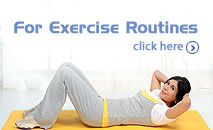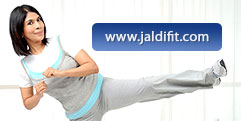 JUMPSTART your exercise program with PLYOMETRICS!
JUMPSTART your exercise program with PLYOMETRICS!
Plyometrics are movements that will power surge your exercise routine, making it challenging, action-packed and fun. Explosive in nature, they increase intensity, build stamina and take you to fitness goals quickly and efficiently.
So put on your shoes and get set for a power-packed fitness routine that will leave you feeling energized and exhilarated…
Plyometric refers to controlled jumps, leaps and bounds. Speed and strength are integral components of fitness found in varying degrees in virtually all athletic movements. When an athlete jumps, a great amount of force is required to propel the body upward; the body must be able to flex and extend quickly to leave the ground. The athlete relies on this quick action to attain the power necessary for the movement.
The combination of speed and strength is power. For many years, coaches and have sought to improve power in order to enhance performance. The distinct method of training for this power or explosiveness has been termed “plyometrics”.
Plyometrics is an advanced training technique aimed at linking strength with speed of movement to produce power. By stretching a muscle tightly and then quickly contracting it, plyometric drills enable a muscle to reach maximum strength in as short a time as possible. With plyometric training, we seek to train (the body’s fast twitch) muscle fibres so that they can load (stretch) more quickly, and in turn, unload more quickly to produce more power. In terms of basic muscular physiology, a pre-stretched or loaded muscle is capable of generating more force than an un-stretched muscle. Plyometric exercises “teach” muscles to respond quickly and powerfully.
These movements were first used in training by the Eastern European countries for Olympic competitions. Perfected by the Russian and Eastern European track and field athletes in the mid-1960’s, this training method has gained worldwide acceptance and credibility through scientific research.
Different sports require the usage of some muscle groups more than the others. For example, soccer requires leg strength more than that of arms. In building speed, vertical leap and explosion plyometrics is highly significant. A basketball player drives to the goal to slam-dunk the ball, on his last step he unloads the “spring” the second he touches the ground. The training of “springs” (in the muscles), which is plyometric training, is therefore an essential part of athletic training.
The result: hopefully he will be jumping high enough to slam-dunk the ball. Performing plyometrics along with a running program will maximize the results.
The bottom line is that, though there are several ways an athlete can prepare for competition, without a serious and determined push, training becomes stagnant and ineffective.
The golden rule of any conditioning program is specificity. This means that the movement you perform in training should match, as closely as possible, the movements encountered during competition. If you are a rugby player practicing for the line-out or a volleyball player interested in increasing vertical jump height, then drop jumping or box jumping may be the right exercise. However, if you are a javelin thrower aiming for a more explosive launch, then upper body plyometrics is far more appropriate.
You don’t have to be an athlete to perform power moves. If you want to make changes to your physique and challenge your training style, you can incorporate this method of training to suit your goals. Remember, unlike traditional body-sculpting workouts that focus on slow, controlled isolation exercises, power training centers on explosive, full-body movements, which are great for burning calories as well as toning muscles.
Remember this when you are about to spend an hour at a sluggish pace on the treadmill or when you are pumping rep after rep on a weight machine. Before you start with this method and attempt such exercises, you do need to ensure that your body is suitably developed and well trained.
Plyometrics training is an excellent way to develop explosive power and acceleration. The great thing about plyometrics is that they can be performed almost anywhere and in a minimal amount of time. Adding a plyometric workout to your program once a week will enable you to raise your intensity level to new heights very quickly. If you play a sport like tennis, you may notice an increase in power in your serve; if you’re a die-hard aerobiciser, you’ll discover untapped stores of energy. That is why power training is a key element for achieving peak fitness performance and giving your body a shapely, lean look.
This type of training utilizes high-energy stores, burns fat and challenges the body and mind. Superior skills and technical abilities are developed with this method. Plyometrics movements develop the whole neuromuscular system for power movements.
This training is just the kind of stimulus needed by the body and mind to break through a plateau and finally bring out that pro-athlete in you!
It is important to ensure that the body is suitably developed and well trained before attempting such exercises. Technique is very important. If possible, try to spend some time with a coach who is experienced in such techniques as you begin to use them. Individuals with a history of stress-induced injuries to the feet, ankle, shin, knees, hips or lower back should not perform plyometric activities without consulting a chartered physiotherapist. Plyometrics, like any form of fitness training, can cause injury if the technique used is incorrect.
Higher than normal forces are put on the musculo-skeletal system during plyometric exercises, so it is important for the athlete to have a sound base of general strength and endurance. Most experts state that a thorough grounding in weight training is essential before you start plyometrics. It has been suggested that an exerciser should be able to squat twice his body weight before attempting depth jumps. However, less intensive plyometric exercises can be incorporated into general circuit and weight training during the early stages of training, so as to progress sensibly. Simply plyometric drills such as skipping hopping and bounding should be introduced first. More demanding exercises such as ‘flying start single-leg hops’ and ‘depth jumps’ should be limited to thoroughly conditioned individuals.
-
Before incorporating these power moves into your workout, learn the correct form and technique to avoid injury
-
If you are new to these moves, build your anaerobic fitness level. Dips, pull-ups, push-ups are great exercises to incorporate since you must learn how to handle your own body weight
-
You also need to build aerobic stamina to be able to complete the power moves without fatiguing prematurely
-
Avoid heavy weight training on days you perform plyometrics
-
Wear good sports shoes to help avoid shock
-
Train on a soft surface (grass, mat, padding)
-
Start slow with just a few plyometrics exercises
-
Perform plyometrics when you’re full of energy
-
Land softly. Be gentle on your joints when you land
-
Bend your knees to protect stressed-out knee joints and enable
-
you to land softly
-
Make full foot contact when you land. Don’t land on your toes or your heels
-
Try to keep your torso erect during the movements. This prevents undue strain on the lower back
Plyometric moves you can add to your workout
Warming up is crucial. Spend 10 minutes jogging or skipping, followed by 10 minutes of stretching the muscles involved
Two sessions per week.
Do 2 sets of 4 to 8 repetitions. Rest for about 3 to 5 minutes between sets.
With regard to this plyometrics training program, you should proceed from low intensity to medium intensity. When your body gets accustomed to these moves, take the intensity level higher. Always progress gradually. Remember to consult a doctor before attempting any of these exercises.
Muscles worked: torso, waist, abs, back, legs
Begin by standing upright with your feet shoulder-width apart. Bend at the knees and jump 90 degrees clockwise, then jump back to starting position. Next, jump 180-degrees clockwise and return to starting position and, finally, jump 360 degrees clockwise. Repeat in the opposite direction. This exercise is great for rotation; it helps you become self-aware while jumping in the air.
Muscles worked: Quads, hamstrings, glutes, calves
Begin by standing upright in a forward lunge position with both knees bent. Now jump straight up, clapping your hands in the air before landing in the same lunge position. Try to land in the same spot that you started from. Jump again immediately, and repeat the exercise for the desired number of reps. Repeat the exercise with the opposite leg forward. This exercise helps you achieve balance and coordination.
Muscles worked: abs, back, legs, glutes
Stand with feet hip-distance apart, knees bent and torso leaning forward with a flat back. Run in place, quickly shifting body weight from the left leg to the right as fast as you can.
Muscles worked: abs, glutes, hamstrings, quads and calves
Take an athletic stance with your feet shoulder-width apart and your knees slightly bent. To initiate each jump, bend your knees to a half squat position, and then instantly leap into the air. Once airborne, use you hip flexors and your abs to pull your knees as high as possible up to your chest. Upon landing, come back into that squat position to reduce the impact on your joints, and then quickly jump up again and try to go higher and bring your knees closer to your chest. Repeat.
Muscles worked: lats, delts, pecs, raps, triceps, abs
Face a wall and hold a medicine ball (4 to 8 pounds) with both hands in front of your body. To begin the movement, quickly bring the ball back behind your head and explosively leap up and throw the ball at the wall. Contract your abs as you release the ball. Repeat.
Muscles worked: glutes, inner and outer thigh, hamstrings, quads and calves
In this exercise, you jump back and forth laterally on a low bench or over a line drawn on the ground. Stand in an athletic position (knees bent, leaning forward slightly on the balls of your feet) and jump off both feet, pull your chin up to your chest to clear the obstacle, and land on the other side of the bench or line. Continue to jump laterally over the obstacle for the desired number of reps.
Muscles worked: pectorals, deltoids, triceps
Lie face down on the ground and raise your body up into a full push-up position. Keep your abs contracted and spine in a neutral position. Now push off the ground with your upper body and quickly clap your hands. Then bend your elbows as you lower your body to about 3 inches off the floor. Push back to staring position and repeat the sequence.
- Benefits of Exercise
- Exercise and the Heart
- Exercise and the Bones
- Exercise and Hypertension
- Exercise Excuses and how to beat them
- Over Exercising is bad for you
- Kids gotta Exercise too!
- What is Obesity
- Fitness Triangle
- Running, Skipping and Cycling
- Walking
- Swimming
- Common Fitness Myths
- Evaluate your Fitness Quotient
- Wellness Tools and Charts



